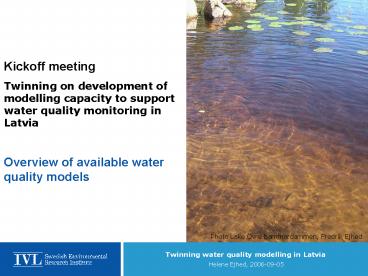Kickoff meeting
1 / 16
Title: Kickoff meeting
1
Kickoff meeting Twinning on development of
modelling capacity to support water quality
monitoring in Latvia Overview of available water
quality models
Photo Lake Övre hammardammen, Fredrik Ejhed
2
Overview water quality models - selection
- Eutrophication and acidification are well known
problems - Water flow and pathways models are numerous
- Nutrients N and P have been extensively
investigated and models tested - EUROHARP project provides model test results
- Water quality models are often chains of
submodels - Priority substances WFD annex X often unknown
transport pathways and fate
3
Euroharp project Towards european harmonised
procedures for quantification of nutrient losses
from diffuse sourceswww.euroharp.org
- All 9 models applied in 3 country catchments
- By lottery applied in 3 additional country
catchments - Susve in Lithuania modelled with MONERIS, REALTA,
SA and NOPOLU - Nationally used models for international report
obligations
4
Processes of water qualityTransport and
retention and source apportionment
point source contributions
denitrification processes
biota cycling, sedimentation
source apportionment
hydrology and flow pathways
leakage of nutrients from landuse
5
Simple balance model within EUROHARP
- SA Source apportionment follows the procedure
by HARP-NUT guidelines - Agricultural load is determined only by
subtraction of other sources (including retention
and background load) from monitored and
unmonitored river load on the sea. - The empirical retention models for lakes require
only the hydraulic loading, water temperature, N
and P loading and an estimate of the P pool in
lakes.
6
Hydrology and flow pathways
- Hydrological descriptions are very important for
pollution load calculations - Only 4 EH models include hydrological module
ANIMO, SWAT, HBV (TRK), EveNFlow - Topography, landuse and soil type divide each
basin into hydrological response units HRU
(ANIMO, SWAT) or subbasins (HBV) or response
groups (EveNFlow) - Daily climate data are drive data
- Major differences in snow routines, surface
runoff descriptions and how water balance is
calculated - SCS (Soil Concervation Service) model
- calculates using flow transport factors dependent
on landuse and soil type. Snow routine and
monitored baseflow can be added. Daily data.
7
Hydrology example results
Top graph shows model flow results vs monitored
data. Low graph shows model transport total N
results vs monitored data. TRK (HBV hydrology)
model
8
Diffuse sources models- agricultural
contributions
- Empirical models
- For example regression analysis of most important
factors for N and P transport - Ex. EH models REALTA and NOPOLU.
- Limited possibilities to scenario calculations
- Process based models with a high resolution are
mainly developed to evaluate the effects of
agricultural management practices or detailed
(sub-)catchment management. - Ex. EH models SWAT, NL-CAT (ANIMO), TRK(SOILNDB)
- Input data heavy
- Expert user
9
Ex. Animo fertilization level, soil management
to nutrient leakage
10
Ex SOILNDB calculates standard N leaching rates
from combinations of soils,crops, normal yield,
normal climate per region
11
Retention models
- Retention recycling within the freshwater
ecosystem - Biota exchange, sediment exchange, atmospheric
exchange and lake compartments exchange etc. - EUROHARP-RETNUT
- Retention capacity derived empirically
12
Application for scenario analysis
- Only few of EUROHARP models were considered
suitable for scenario analysis (predicting
effects of measures) - MONERIS, NL-CAT(ANIMO), SWAT, TRK (SOILNDB)
- But MONERIS cannot be used for water measures
13
Watshman PC tool Data management, pollution
flow, source distribution and action/investment
scenarios
14
- Data management and presentation options as
selecting, editing, simple calculations and usual
GIS functions. ArcHydro connections under
development.- Nutrient transport options with
chains of models as diffuse leakage, lake
retention model etc.- Scenario management
options as changes in crop, landuse, sewage
treatment etc.
15
Results for Lithuania Susve river catchment
- MONERIS performed well
- difficulties in DIN peak year
- Susve 34 N retention and 66 P retention
- REALTA only calculates risc
- NOPOLU no results yet
16
Proposal to approach in Latvian application
- WFD demands
- Typology
- Reference conditions
- Characterisation
- Pressures
- Measures
- Get a quick overview using simple balance
calculations if data are available - Identify problem issues, ex. eutrophication
acidification, other pollutants, hydrological
issues resolution etc. - Identify important processes, ex. snow routines,
flooding, sediment transport, wetland and lake
processes etc. to apply the right models. - Use combinations of well known models tested from
similar areas.































